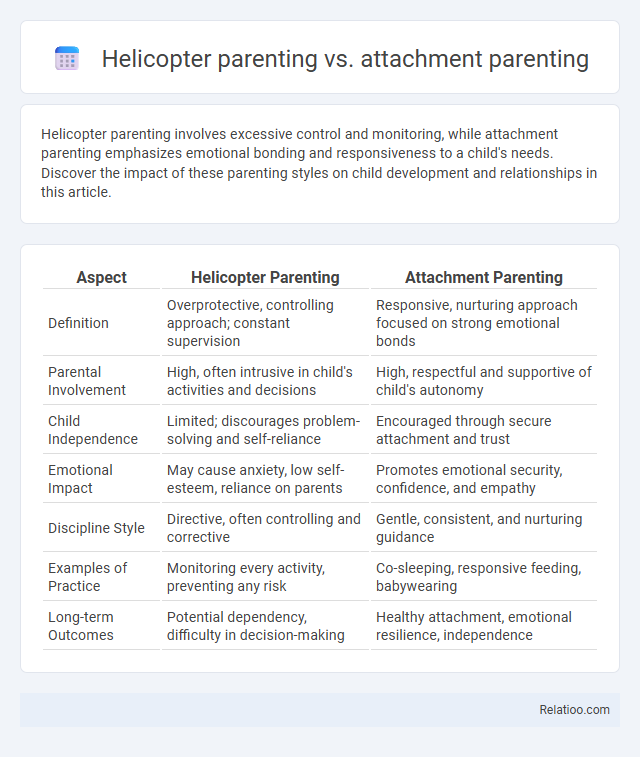Helicopter parenting involves excessive control and monitoring, while attachment parenting emphasizes emotional bonding and responsiveness to a child's needs. Discover the impact of these parenting styles on child development and relationships in this article.
Table of Comparison
| Aspect | Helicopter Parenting | Attachment Parenting |
|---|---|---|
| Definition | Overprotective, controlling approach; constant supervision | Responsive, nurturing approach focused on strong emotional bonds |
| Parental Involvement | High, often intrusive in child's activities and decisions | High, respectful and supportive of child's autonomy |
| Child Independence | Limited; discourages problem-solving and self-reliance | Encouraged through secure attachment and trust |
| Emotional Impact | May cause anxiety, low self-esteem, reliance on parents | Promotes emotional security, confidence, and empathy |
| Discipline Style | Directive, often controlling and corrective | Gentle, consistent, and nurturing guidance |
| Examples of Practice | Monitoring every activity, preventing any risk | Co-sleeping, responsive feeding, babywearing |
| Long-term Outcomes | Potential dependency, difficulty in decision-making | Healthy attachment, emotional resilience, independence |
Understanding Helicopter Parenting: Key Characteristics
Helicopter parenting is characterized by excessive involvement in a child's life, often leading to overprotection and micromanagement of daily activities. This parenting style contrasts with attachment parenting, which emphasizes emotional bonding and responsiveness to a child's needs without controlling every aspect. Understanding helicopter parenting involves recognizing behaviors such as constant monitoring, interference in decision-making, and a reluctance to allow children to face natural consequences.
Defining Attachment Parenting: Principles and Practices
Attachment parenting emphasizes creating a strong emotional bond between parent and child through responsive caregiving, physical closeness, and consistent nurturing. Principles include practices such as babywearing, extended breastfeeding, co-sleeping, and gentle discipline to foster security and trust. While helicopter parenting involves over-monitoring and controlling behavior, attachment parenting focuses on empathy, sensitivity, and supporting the child's emotional development without hovering.
Origins and Evolution of Parenting Styles
Helicopter parenting, emerging in the late 20th century, is characterized by parents' over-involvement in children's lives to prevent failure and ensure success, often linked to increased competitive societal pressures. Attachment parenting, rooted in Bowlby's attachment theory from the mid-20th century, emphasizes nurturing a secure emotional bond through practices like responsive caregiving and prolonged close contact. Your understanding of these distinct origins reveals how evolving social contexts and psychological insights have shaped diverse parenting styles with unique impacts on child development.
Emotional Impact on Children: Comparing Outcomes
Helicopter parenting often leads to increased anxiety and low self-esteem in children due to overprotection and lack of autonomy, whereas attachment parenting fosters secure emotional bonds and resilience through consistent responsiveness and physical closeness. The emotional impact of attachment parenting typically promotes better emotional regulation and social competence compared to the dependency and stress observed in children of helicopter parents. Balancing involvement with independence is crucial to avoid the negative emotional outcomes seen in excessive helicopter parenting while maintaining the emotional security emphasized in attachment parenting.
Autonomy vs. Attachment: Finding the Balance
Helicopter parenting often limits your child's autonomy by closely supervising every aspect of their life, while attachment parenting emphasizes secure emotional bonds and responsiveness to a child's needs. Striking a balance involves fostering independence without sacrificing the strong emotional connection essential for healthy development. Prioritizing both autonomy and attachment helps children build confidence and resilience alongside a safe, supportive foundation.
Effects on Child’s Academic and Social Development
Helicopter parenting often results in children struggling with independence and problem-solving, as excessive parental involvement can hinder their ability to develop critical academic and social skills. Attachment parenting fosters secure emotional bonds that positively influence a child's confidence and cooperation in school and social settings, promoting resilience and empathy. Your awareness of these parenting styles is crucial in choosing an approach that supports balanced academic achievement and healthy social development.
Common Misconceptions and Stereotypes
Helicopter parenting is often misunderstood as simply being overprotective, but it more specifically involves excessive control that can hinder children's independence, while attachment parenting is frequently stereotyped as overly permissive despite its emphasis on nurturing secure emotional bonds. Common misconceptions conflate helicopter parenting with attachment parenting, overlooking that attachment parenting promotes responsiveness and emotional availability rather than control. Both parenting styles face stereotypes that oversimplify their intentions, ignoring the nuanced balance between guidance and autonomy they aim to achieve.
Expert Insights: What Research Says
Research reveals distinct impacts of Helicopter, Attachment, and Free-range parenting styles on child development; Helicopter parenting often leads to increased anxiety and reduced autonomy, while Attachment parenting promotes secure emotional bonds and social competence. Free-range parenting encourages independence and problem-solving skills but may raise safety concerns among caregivers. Your choice of parenting style influences your child's emotional well-being, resilience, and ability to navigate challenges effectively.
Deciding What Works for Your Family
Deciding what works for your family involves understanding the distinct approaches of helicopter parenting, attachment parenting, and free-range parenting, each offering unique benefits and challenges. Helicopter parenting emphasizes close supervision and intervention, attachment parenting focuses on emotional bonding and responsiveness, while free-range parenting promotes independence and self-reliance in children. Evaluating your family's values, children's temperaments, and lifestyle can help create a balanced parenting style that supports healthy development and fosters trust and security.
Parenting in the Modern World: Trends and Takeaways
In the modern world, parenting trends like helicopter parenting, attachment parenting, and tiger parenting reflect diverse approaches to child-rearing with unique emotional and developmental impacts. Helicopter parenting involves intense supervision to prevent failure, often limiting children's autonomy, while attachment parenting emphasizes nurturing strong emotional bonds through practices like co-sleeping and responsive caregiving. Tiger parenting, characterized by strict discipline and high expectations, contrasts with the supportive responsiveness of attachment parenting, highlighting the spectrum of parenting styles influencing children's resilience and independence in contemporary society.

Infographic: Helicopter parenting vs Attachment parenting
 relatioo.com
relatioo.com